“We know we have a lot of work to do… we need ODOT to shift from the typical auto-oriented focus.”
– Sharon Daleo, PBOT
Looking to reassure advocates about the I-5 Rose Quarter project, a City of Portland staffer told the Bicycle Advisory Committee meeting this week that it’s too early to panic and everything will be just fine.
On Monday we shared graphics from an unreleased draft of the Oregon Department of Transportation’s I-5 Rose Quarter Supplemental Environmental Assessment (SEA). The document is a requirement under federal law and it comes in response to a significant change in the project’s scope. After pressure from elected officials and advocates forced ODOT to include a much more robust highway cover (that would allow development on top of it) in the project, the state came up with what they call the “Hybrid 3” design option. The SEA takes a closer look at this design.
We received a copy of the SEA this week from advocates with No More Freeways who warned that ODOT’s first draft of surface street designs make conditions much worse for anyone outside of a car.
At the outset of her presentation at the BAC meeting Tuesday night, Portland Bureau of Transportation Rose Quarter Project Manager Sharon Daleo spoke directly to these concerns. “We know we have a lot of work to do,” she said. “We recognize that we need our partner ODOT to shift from the typical auto-oriented focus.”
It’s important to understand that PBOT walked away from this project two years ago and only re-engaged this past summer. That means ODOT (a more conservative and driving-centric agency) did nearly two years of project design and development without PBOT’s input or oversight. Now the city must play catch up. And because this project is deeply unpopular with a large swath of Portland’s transportation-focused electorate, PBOT has strong motivation to make sure the project — which will add lanes to a freeway — does not reverse climate and mobility goals.
With that context in mind, PBOT’s Daleo told BAC members that, “Our efforts are focused on finding a design that aligns with city policies and guidelines that prioritize equity and climate and those walking, rolling and taking transit.” Daleo repeatedly mentioned how PBOT feels there’s “flexibility” in the process going forward and tried to reassure people that the project will result in a net benefit.
Here’s more from Daleo:
“Our understanding of the Hybrid 3 purpose and intent was a design approach that shifts from an auto-focused street environment, to a pedestrian-oriented system that prioritizes pedestrian safety and experience — making the streets around new development opportunities and highway covers to be more people and business friendly, with less I-5 traffic circulating through the area.”
Importantly, Daleo referenced an intergovernmental agreement (IGA) between ODOT and PBOT that includes not only more public outreach but also a requirement for ODOT to return to Portland City Council for approval in 2024. She also said PBOT feels Oregon Governor Kate Brown’s memo from August gives them significant power to re-evaluate ODOT’s designs.
The SEA is ODOT’s interpretation of the Hybrid 3 option, but according to PBOT, the City of Portland will have final review and approval of how the surface streets are designed. Keep in mind however, that in the end this is an ODOT project. Daleo made it clear (at one point even correcting herself) that PBOT can only “analyze” the designs and does not have the power to “develop” them.
Dru Van Hengel, a project consultant from planning firm Nelson Nygaard (who also sits on The Street Trust Board of Directors), also aimed to reassure BAC members. “This design is far enough along for [federally required] environmental evaluation. There are many details still to explore, review and approve.” Specifically, Van Hengel said they will start design conversations with protected bike facilities. And when it comes to some of the scary highway ramp exposures on Williams we pointed out on Monday, she said, “We’re looking to reduce the extent of the crossing exposure both for people walking and biking.”
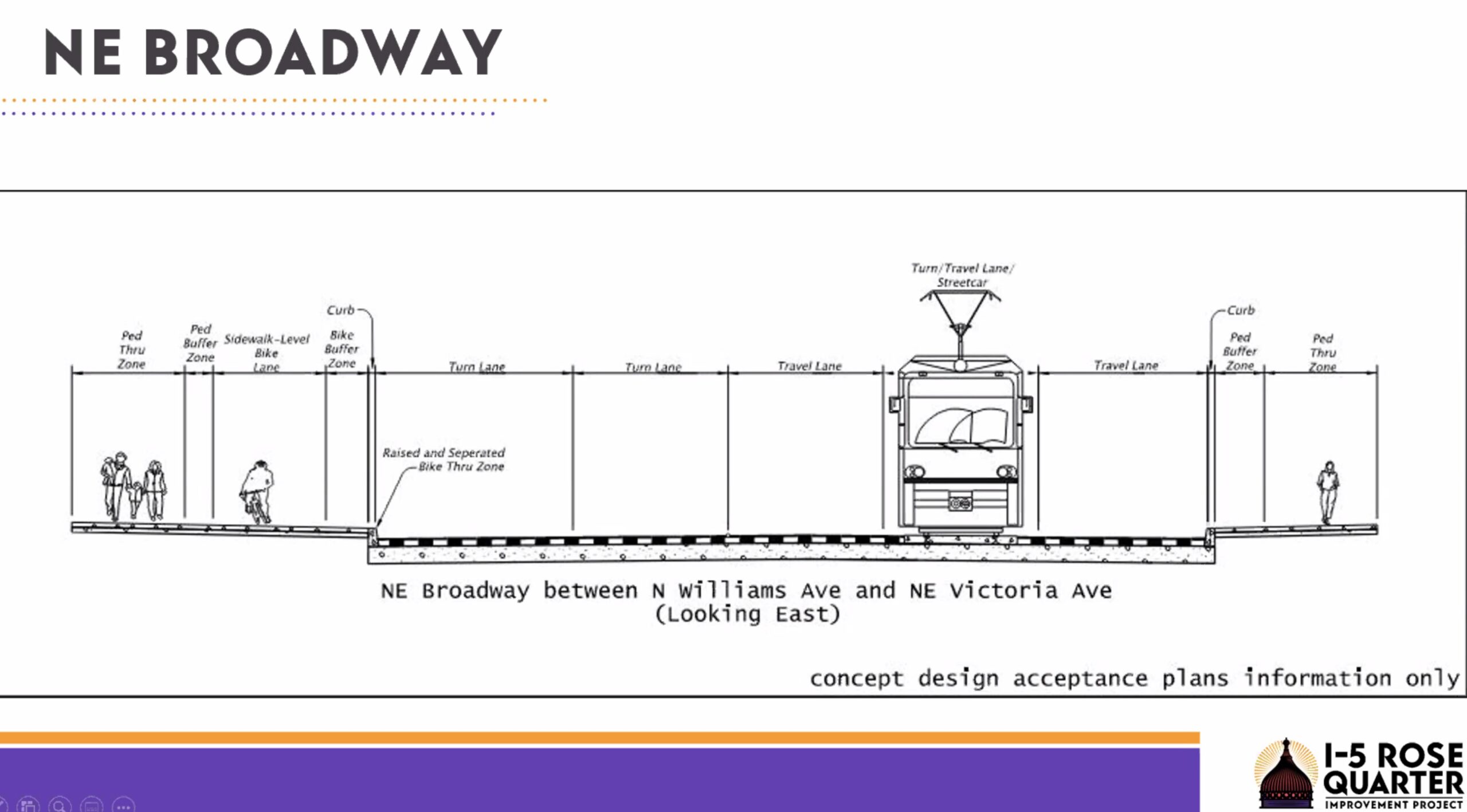

Since the route of the Green Loop will be retrofitted to the Broadway-Weidler couplet (busy streets that currently have terrible bikeways), Van Hengel sought to assuage concerns by showing a cross-section for what’s to come. The drawing showed physically-separated and raised facilities that will have shorter crossings, striping and bike-only signals at intersections. “We will be looking to make the Green Loop the best it can be given where it will be in the project area,” she said.
This is all part of a very tricky dance we’ll watch closely in the coming months and years as PBOT and ODOT awkwardly try to satisfy their respective constituents and complete this project. The city and state are co-dependent: ODOT needs PBOT’s support to make the politics pencil out; PBOT needs the project to get built so they can implement more dense development on freeway-adjacent parcels that requires ODOT’s approval.
ODOT expects the FHWA to make a final decision on their environmental analysis in spring 2023 and, if all goes according to plan, crews would break ground later that year. Major construction would then begin in 2026 and the project would be complete by 2030. ODOT will release the SEA to the public and launch an open house any day now.



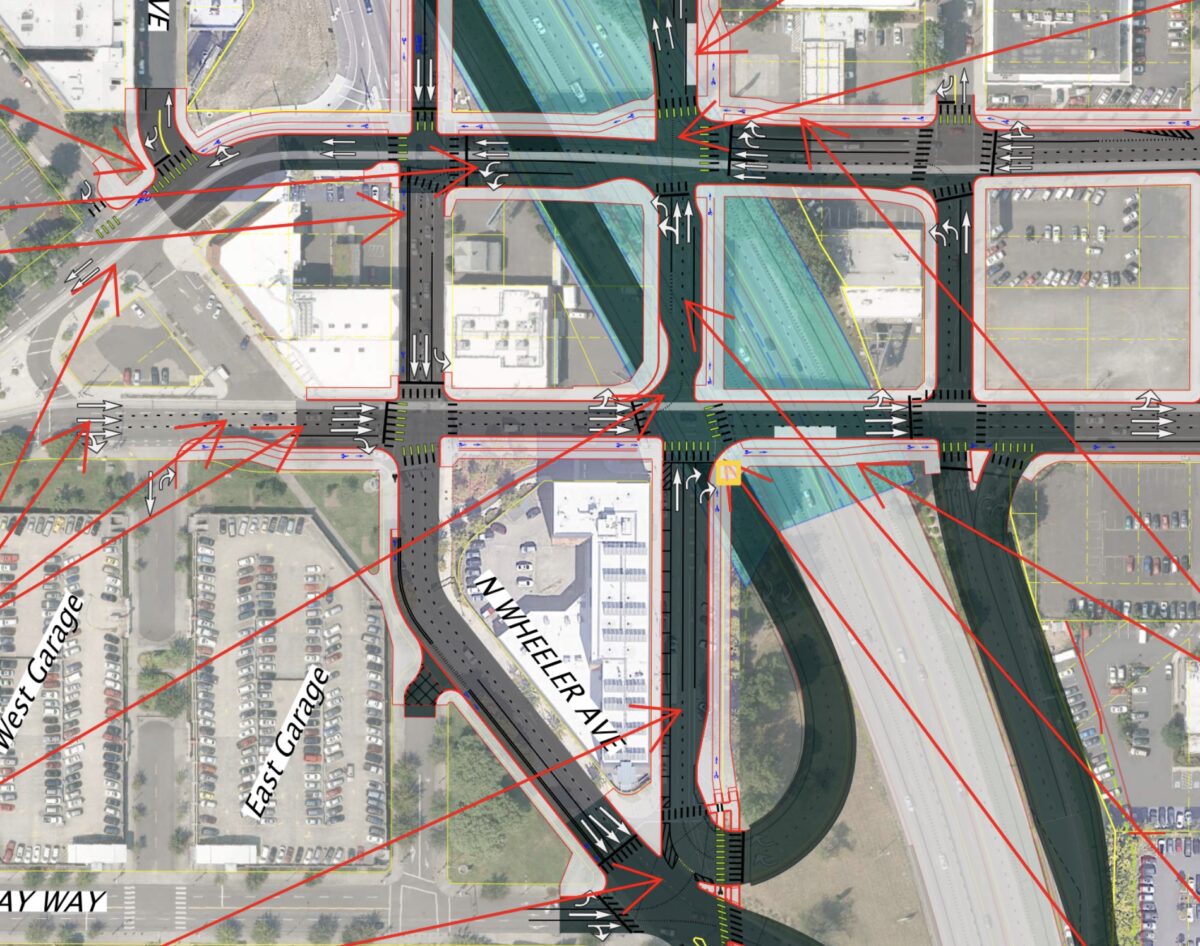
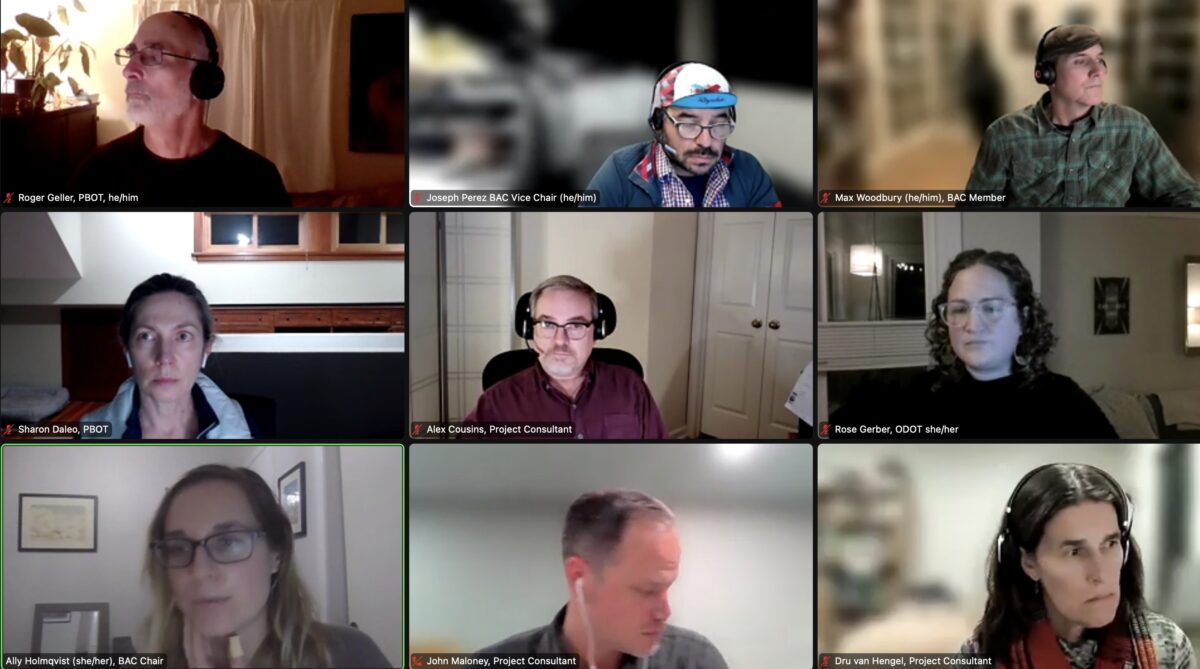

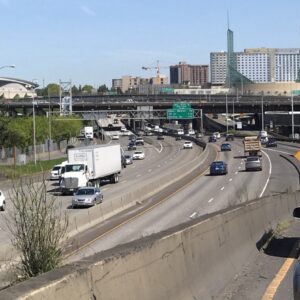

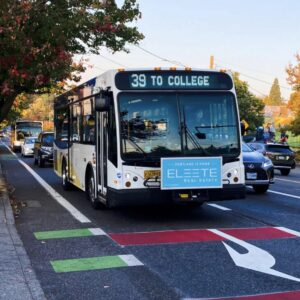
Thanks for reading.
BikePortland has served this community with independent community journalism since 2005. We rely on subscriptions from readers like you to survive. Your financial support is vital in keeping this valuable resource alive and well.
Please subscribe today to strengthen and expand our work.
Should anyone believe the PBOT claim that we’ll just “fix this later”?
Is PBOT clueless, naive, or in on the con?
It’s clueless to suggest that the Environmental Assessment is just a vague and malleable rough draft. The whole purpose of the Environmental Assessment (EA) is to define and fully disclose the project’s impacts so that they can be mitigated and fixed BEFORE the project is approved. Legally, the federally required EA is supposed to have enough finality and detail that the public can fully judge the effects of the project–and keep in mind ODOT bills this as a “safety” project. How can anyone have any confidence of how it will affect safety when all these design features are up in the air? Just as an example, keep in mind that it was only through the EA process in 2019 that advocates forced ODOT to disclose and then eliminate the proposed widening of the freeway above the Eastbank Esplanade.
https://bikeportland.org/2020/11/12/odot-modifies-i-5-expansion-plans-to-prevent-esplanade-impacts-322711
Naive: once the EA is finalized and the Record of Decision is issued, ODOT has the hammer. They can argue–just as they are arguing with the Interstate Bridge Project right now: “we can’t make any changes or we’ll have to re-do the environmental analysis.” That’s true regardless of any assurances from soon-to-leave office Governor Brown. Also: vague promises to “fix” something don’t have any legal weight, and ODOT can easily forget or “value-engineer” those promises into oblivion.
In on the con: PBOT is simply providing cover for ODOT to push through the record of decision, after which there will be little or no opportunity to make meaningful changes to the project. If the past half century has taught us anything its that letting your state highway department design city streets is a recipe for a dangerous, car-choked neighborhood. If you don’t have the brains, guts or clout to get these changes now, what makes you think you’ll have them two or three years from now when ODOT is running bulldozers and pouring concrete?
The time to resolve these issues is now, during the environmental assessment process. Once ODOT publishes the EA and gets its ROD, your ability to influence what they do is almost nil.
I think PBOT is probably clueless about this. I am sure therea re some staff who are experienced enough to know their limitations and responsibilities with regard to an ODOT project project with Federal funding, but I uspect their are many more who assume PBOT has a lot more sway than it actually has. Those in the know are likely ambivalent or maybe even supporters of this. PBOT says. “don’t worry, we care about bikes and pedestrians” a lot, but look at what they do and ignore what they say. They do not care about bikes or pedestrians.
PBOT has the jurisdiction to make the onramp approaches in Portland freight and bus only. With help from ODOT we could make the off-ramps freight and bus only also. That would mean a lot fewer cars in the city. This is popular with everyone, especially folks concerned about finding parking.
Unfortunately when PBOT roads come anywhere near ODOT on-ramps, even though PBOT owns the right of way they don’t get to do what they want without getting input and approval from ODOT.
The N. Williams ramp move is purely bad for everything other than maybe walkability on the highway cover, and there is no way around it. It’s worse for drivers, freight, pedestrians (not on the cover), and bikes. The ramp is being moved to alleviate traffic on a piece of real estate ODOT is spending $1 billion on.
It’s worth calling this out as what it is – a scheme to increase the development value of the central aspect* of this project. And I think it’s a bit of a conflict of interest for ODOT to do something like that personally. Will the highway cover be an integrated part of the urban fabric in the area, or will it be an island in a sea of surface parking lots and fast traffic? There is a lot of work to be done outside the scope of this project if that want it to be the former.
*well at least as marketed – the real central aspect of the project is supposed to be “fixing congestion” in the Rose Quarter, but that isn’t very clear from reading any of the materials.
Genuine question: is the project planning on acquiring the Shell station on NE Broadway? Because if not, that cross section for Broadway between N Williams and NE Victoria is not buildable on anything more than a small percentage of the frontage.
If they purchase it or condemn it by eminent domain, remediating that Shell station will cost a substantial chunk of change all by itself.
5th paragraph: “(a more conservative and driving-centric agency)”
I am not sure you can say that witha straight face anymore. PBOT has become very conservative adn driving-centric. ODOT is building a bike/ped tunnel through a mountain with side-light tunnels and beautiful details.
Double right turn lane from Northbound Williams to Eastbound Weidler, in whose universe is that going to be ‘just fine’?!?!?! This new proposal is yet another heaping pile of stinking dung.
I sense PBOT is feeling a bit territorial- closing pedestrian is THEIR game- ODOT needs to step off!
It seems to me like the current location of the southbound off-ramp is in the right place. Tons of people get off there to go to the Moda Center parking garages, and this new location requires a tortured route going up Williams, left on Broadway, left on Vancouver. It’s going to be a crazy car sewer at all times but especially on game and concert days. Signal timing doesn’t work well if traffic flows are a series of left turns. It’ll be a disaster. Why move the ramps at all? Better yet, why have freeway ramps in this area at all?
one of the ODOT consultants said they want to move the ramps away from the central part of the freeway cover so that it will be more likely to create the type of dense, walkable urban feel that Albina Vision Trust wants.
Hmm…it seems like this change will make the entire area less walkable though, by having all these swooping double-left and double-right turns. Not a good trade.
I don’t understand why the SB ramp traffic is blocked from going WB on Ramsay. That seems like the obvious connection for cars needing to access the Moda Center and the Broadway Bridge. It would probably make sense to connect Ramsey to Benton directly at the west end for cars accessing the Broadway bridge.
This has the added benefit of reducing traffic on Broadway/Weidler. Am I missing something? Is the Moda center throwing its weight around?
Did my comment end up in spam?
No Watts, your comment ended up in trash. You can email me or JM if you want to discuss.
Did it say anything unfair or untrue?
Hi Watts,
No. I deleted it. I felt like it was inappropriate. Feel free to email me if you want to chat further.
Ok, well tell me this: was it my criticism of ODOT’s citizen advisory panel (and if so was it my remark about it’s non-assertiveness on the topics important to readers here, or ODOT’s selection criteria), or my criticism of the idea that non-professionals should not critique engineering/street design projects that folks (such as yourself) bandy about from time to time?